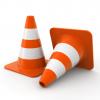- Describe how the environment keeps infants and toddlers safe outdoors.
- Identify your role in keeping the outdoor environment safe for infants and toddlers.
- Apply the information from this lesson to keep infants and toddlers safe when outdoors.
Learn
Know
Outdoor physical play provides infants and toddlers much-needed exercise, sunshine, and the opportunity to practice motor skills in a different setting. As you will learn in Lesson Four, outdoor environments have different safety hazards than indoor settings.
The National Program for Playground Safety recommends that child-care programs consider four categories for ensuring playground safety. The S.A.F.E. categories are:
Supervision
Age appropriateness
Fall surfacing
Equipment maintenance
Supervision
Active supervision is key to keeping infants and toddlers safe. Active supervision involves moving, scanning, predicting, and adjusting. It can look like moving through the outdoor space, scanning children and the environment for hazards, predicting potential hazards, and adjusting the environment to make necessary changes. Safe equipment and play spaces are important, but nothing replaces active supervision.
Age Appropriateness
Infants and toddlers are continually discovering new skills, practicing emerging skills, and mastering skills. They could be in different stages of skill development when it comes to motor skills. They may have mastered walking, are practicing running, and discovering climbing. Equipment and surfaces must safely support the three levels of developing motor skills. A wide variety of equipment and materials for infants and toddlers to use outdoors will support their development.
Here are some ways safety is influenced by development:
- Cognitive development: Infants and toddlers are not yet able to predict hazardous situations or see cause-effect relationships in their interactions.
- Language and communication development: Infants and toddlers have a limited vocabulary and may not understand sentences like "That is dangerous."
- Emotional development: Infants and toddlers lack impulse control to the point they cannot always stop the urge to act, even in unsafe situations.
- Motor development: Infants and toddlers have limited ability to coordinate movements and maintain balance.
Fall Zone Surfacing
Children may fall when they play. It is your job to reduce the frequency and severity of falls. Maintaining proper surface cushioning surrounding equipment and proper spacing of equipment will help minimize injuries, so will using the correct height of equipment. Equipment should let children practice skills but should not be too challenging. If you have any concerns with fall surfacing, report them to your administrator right away.
Equipment Maintenance
All materials and equipment must be in good working condition. There should be no evidence of damage, protrusions that could entangle clothing, or gaps in which a child’s head or fingers could become stuck. Another hazard for infants and toddlers can be excessively hot or cold play surfaces. If you observe any concerns with equipment, report them to your administrator right away.
See
There are many rules and regulations for equipment, spacing, and materials. Playground checklists often are for children 2 and older, but infants and young toddlers should have daily access for play outdoors as well. Watch the following video to learn more about conducting playground safety checks.
Outdoor Safety Check: Infant Toddler
Do
Similar to the indoor environment, it can be helpful to look at your playground from an infant’s or toddler’s viewpoint. Have you ever looked at your playground while on your knees? Doing so shows us how infants and toddlers view the world and everything in it. Adults cannot always see everything from our bird's-eye view.
In order to ensure the safety of infants and toddlers in an outdoor environment, be aware of the following procedures:
Explore
As infants and toddlers grow, they explore the outdoor environment in different ways based on their development—through crawling, standing, walking, running, climbing, and grasping objects. In the Outdoor Exploration Reflection activity, think about how the children in your care explore outdoors, what materials they use, and what injuries might occur at their stage of development. Consider the safety precautions you can take to prevent injuries while still encouraging safe, active play. Share your responses with your trainer, coach, or administrator.
Apply
Review the Safe Outdoor Environments Checklist activity and use it in your outdoor play area. Document the date safety issues were resolved. When complete, share with your trainer, coach, or administrator.
Glossary
Demonstrate
American Academy of Pediatrics, American Public Health Association, National Resource Center for Health and Safety in Child Care and Early Education. (2019). Caring for our children: National health and safety performance standards; Guidelines for early care and education programs. (4th ed.). Itasca, IL: American Academy of Pediatrics. https://nrckids.org
American Academy of Pediatrics. (2021). https://www.aap.org
Cryer, T., Clifford, D., & Harms, R. M. (2006). Infant/Toddler environment rating scale revised edition. New York, NY: Teacher's College Press. https://www.fpg.unc.edu/~ECERS/
The Frank Porter Graham Child Development Institute at the University of North Carolina. (2009). Playground information to use with the environment rating scales. Environment Rating Scale Family of Products. https://ers.fpg.unc.edu/sites/ers.fpg.unc.edu/files/playground%20revised%2009-28-11.pdf
National Program for Playground Safety. (2021). https://www.playgroundsafety.org


